
www.yahoo.com
Much of What We Thought About Neanderthals Was Wrong. Here’s Why That Matters
Modern archaeology paints a truly compelling portrait of our oft-misunderstood relatives
Science & Tech
The Neanderthals never really had a chance. I’m not talking about 40,000 years ago, when we see their remains disappear from the fossil record, but about their rediscovery many millennia later, at a moment when a very particular cultural hierarchy was the order of the day. That another sort of human entirely had once walked the Earth was a deeply shocking fact, one among a volley of disturbing threats lobbed by science against the notion that the cosmos centered on us, Homo sapiens. From 1856—the year they were first noticed—until the present day, Neanderthals have consistently been framed in opposition to us, not as fellow travelers along evolution’s swift and mighty cataract.
But archaeology as a discipline wasn’t paying attention to the role we wished to cast Neanderthals in. Instead, it was busily learning how to do more than simply collect beautiful stony trinkets and arrange them in shape order. Now, we can zoom out from the micro-layers of a single hearth whose embers last glowed in Iberia 90,000 years ago, to the secrets of continental-scale population movements buried in DNA from a Neanderthal woman living around the same time, thousands of miles east in Siberia. Today’s vision of these ancient relations is as distant from old views of Neanderthals—unintelligent cave thugs, the losers of our family tree—as modern astronomy is from the idea of a universe bounded by the Milky Way. And what 21st century archaeology paints is a truly compelling portrait, of another kind of human, traveling their own path.
Particularly in the last three decades, many conventional theories about Neanderthals have been exploded. For example, for much of the past 160 years, it was believed they were specifically adapted to extreme cold; now we know that their environmental range was far broader, and they didn’t really enjoy hyper-frigid conditions. This variety of environments brought with it a massive diversity in ways to make a living. Neanderthals were top hunters who took on prey ranging from true mega-fauna like mammoths and woolly rhinos to small game. Whether hunting or foraging, a deep knowledge of the world guided them—they knew the best way to take apart a reindeer, how to roast a tortoise or where to gather water-lily roots.
Neanderthals were also keenly concerned with the characteristics of materials—most obviously rock. Stone tools connected every aspect of life. They sliced, chopped and scraped the food they ate, the clothing they wore, the fuel that kept the darkness at bay. Patterns from many hundreds of archaeological sites show they understood how different rock types required varying approaches for knapping, and were flexible enough to alter and combine techniques for acquiring the sorts of flakes—and sometimes blades and points—they were after. Study of other materials, such as wood, reveals the same impression of knowledgeable craft. Nor did they use that knowledge for tools alone. While standards of proof are justifiably high (although often more stringent than we demand from early H. sapiens contexts), there do seem to be some striking hints that their material engagements went beyond the functional. For example, a fossil shell from an Italian site dating around 55,000 years ago must have been originally found by a Neanderthal some 60 miles away from the site, and its outer surface bears red pigment, itself sourced from 25 miles away.
Recent discoveries even challenged the Neanderthal “fact” about which we were most certain: their extinction. That changed when in 2010 the first nuclear genome revealed that, rather than their being distant cousins we’d shoved aside by 40,000 years ago, ancient interbreeding had left a genetic Neanderthal legacy in most living people. Of course, it’s obvious that Neanderthals aren’t “still here” in a full sense; since we still look like ourselves, there cannot have been a total Borg-style assimilation. But neither are they totally extinguished.
























































